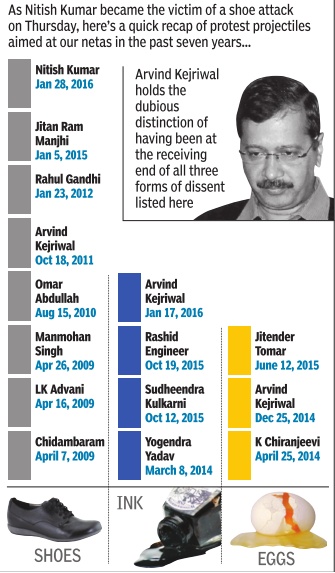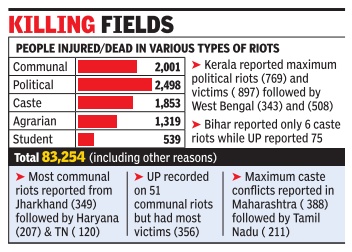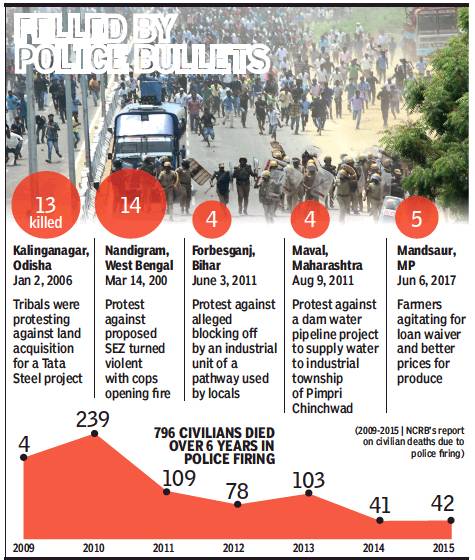Agitations/ protests, political and other: India
This is a collection of articles archived for the excellence of their content. |
Contents |
The legal position
If protesters turn violent, leaders must present themselves to police: SC/ 2018
If protesters turn violent and vandalise property, their leaders must present themselves for questioning at a police station within 24 hours, failing which they will be proceeded against as suspects first and absconders later, the Supreme Court has said.
“In instances where a group or organisation has staged a protest or demonstration resulting in violence and damage to property, leaders and office-bearers should physically present themselves for questioning on their own within 24 hours in the police station within whose jurisdiction the violence and damage occurred,” a bench of CJI Dipak Misra and Justices A M Khanwilkar and D Y Chandrachud said on Monday.
Writing the judgment for the bench, Justice Khanwilkar said, “Any such person(s) failing to present himself or herself in such manner without any sufficient reason should be proceeded against as a suspect and legal process initiated forthwith, including for being declared absconder in accordance with law.”
This will have serious implications, particularly for leaders of fringe groups, as protests over issues like religion, cow protection, films or even political ideologies often turn violent. Turning the screws on such protests, the SC said leaders will be granted bail only if they deposit the estimated cost due to loss or damage, either individually or collectively.
“A person arrested for either committing or initiating, promoting, instigating or in any way causing to occur any act of violence which results in loss of life or damage to property may be granted conditional bail upon depositing the quantified loss caused due to such violence or furnishing security for such quantified loss. In case of more than one person involved in such act of violence, each one of them shall be jointly, severally and vicariously liable to pay the quantified loss,” the SC said.
The three-judge bench fell back on its judgment providing the mechanism to stop lynching incidents and said the nodal officer appointed for each district for curbing such violence would also act to initiate action in vandalism incidents.
“Since the nodal officer (s) holds the overall responsibility in each district to prevent mob violence against cultural establishments and against property, any unexplained and/or unsubstantiated delay in filing FIRs and/or conducting investigations in that regard should also be deemed to be inaction on the part of the said nodal officer(s),” it said.
“The said nodal officer(s) would also be responsible for creating and maintaining a list containing the various cultural establishments, including theatres, cinema halls, music venues, performance halls and centres and art galleries within the district, and pin point vulnerable cultural establishments and property which have been attacked or damaged by mob violence over the past five years.
This list would be updated on a regular basis to account for any new opening and closing of establishments,” it added. Download The Times of India News App for Latest India News.
Year-wise trends
Political agitations, 1973-2015

See graphic:
Political agitations, 1973-2015
Police firing on civilians/ 2004-13
Apr 09 2015
In the past ten years, police firing has caused over 2,500 civilian deaths in India while injuring over 4,000 people. The highest deaths were reported in Uttar Pradesh, Andhra Pradesh, Jammu & Kashmir, Maharashtra, Chhattisgarh and Madhya Pradesh. No firing deaths were reported in Goa, Himachal Pradesh, Nagaland, Sikkim and all the UTs except Delhi. In 2013, police firing was in most cases related to riot control (50.4%), anti-extremist and anti-terrorist operations (27.8%), against others (not classified18.1%) and anti-dacoit operations (3.6%).
Attacks on politicians with shoes, ink and eggs, 2009-16

See graphic:
Attacks on politicians with shoes, ink and eggs, 2009-16
2014: Political riots deadlier than communal riots

The Times of India, Aug 20 2015
Deeptiman Tiwary
Claimed 400 more in 2014, reveals NCRB data
Political riots deadlier than communal ones
More people get injured or killed in politica riots than in communal con flagration. According to lat est data released by Nationa Crime Records Bureau (NCRB), in 2014, there were over 2,400 victims of politica violence, while 2,000 people were injured or killed in com munal riots. According to the data most communal incidents were reported from Jhark hand (349) followed by Harya na (201). West Bengal and Ta mil Nadu had over 100 incidents each while Maha rashtra recorded 99 cases.
UP, which witnessed one of the worst communal riots in 2013, recorded only 51 cases last year but had maxi mum number of victims at 356. Maharashtra followed UP closely with 355 victims followed by Jharkhand with 349 victims.
Caste clashes were the third biggest reason for con flicts with over 1,800 people either getting injured or killed in riots on caste lines.Curiously , however, conflicts of Dalits and tribals with upper caste resulted in far lesser injuries and deaths as compared to other inter-caste conflicts.
According to the data, 507 people became victims of riots caused by clashes between people belonging to scheduled castes and tribes and those not from the cate gory . On the other hand, 1,346 people became victims of other caste conflicts.
Most conflicts between Dalits and non-Dalits were reported from Maharashtra with 147 riots and 183 victims.It was followed by UP with 66 cases and 101 victims. Bihar, curiously , recorded no such cases. Maharashtra again led the pack with 241 cases in other caste conflicts category followed by Tamil Nadu with 182 such cases.
2006-17: police firing

From: May 23, 2018: The Times of India
See graphic:
2006-17: Agitations on which police had to fire, leading to the death of civilians
